rotation and area
Point A is rotated to point B. Can you find the area of the triangle that these points make with the origin?
Problem
A has coordinates (4,4) and B is obtained by rotating A about the origin O through an angle of 135 º anti-clockwise.
Calculate the area of triangle AOB.
This problem is taken from the World Mathematics Championships
Student Solutions
First, it is necessary to work out where B is.
Since A is 4 up and 4 along from the origin, OA makes a $45^\circ$ angle with the $x$ axis. This means that the obtuse angle between OA and the $x$ axis must be $135^\circ$, so B must lie on the $x$ axis. This is shown in the diagrams below, where the red triangle is the triangle whose area we need to find.
Image

Image
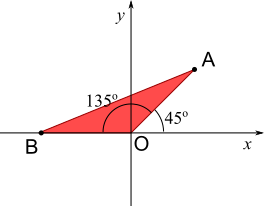
The distances OA and OB are equal, since OB is just a rotation of OA. This distance can be found by considering the triangle below:
Image
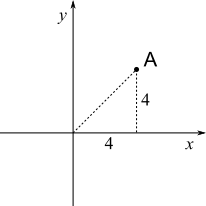
This triangle is right-angled and OA is the hypotenuse, so, by Pythagoras' Theorem,
${\text{OA}}^2=4^2+4^2=2\times4^2$ or $32$,
So $\text{OA}=\sqrt{32}=5.657$ or $4\sqrt2$.
Now, there are various different possible methods.
Using the area of a triangle formula
Area = $\frac12$ base x height
= $\frac12$ OB x $y$ coordinate of A
= $\frac12$ x $4\sqrt2$ x 4
= $8\sqrt2$
Using horizontal and vertical triangles and rectangles
Image
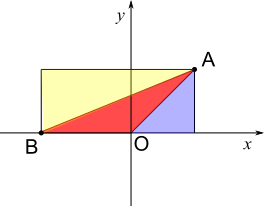
The yellow and blue triangles are drawn to make a rectangle with the red triangle. The length of the rectangle is OB plus the $x$ coordinate of A, so it is $4+4\sqrt2$ or $4+5.66=9.657$
The height of the rectangle is the $y$ coordinate of A, which is $4$.
So the area of the rectangle is $4(4+4\sqrt2)=16+16\sqrt2$ square units, or $4\times9.657=38.63$ square units.
The area of the yellow triangle is half of the area of the rectangle, so the area of the red and blue triangles combined is also equal to half the area of the rectangle. That area is $(16+16\sqrt2)\div2=8+8\sqrt2$, or $38.63\div2=19.31$, square units.
The blue triangle has base $4$ and heght $4$, so its area is $\frac124\times4=8$ square units.
So the area of the red triangle is $8+8\sqrt2-8=8\sqrt2$, or $19.31-8=11.31$, square units.
Using trigonometry
Image
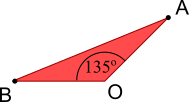
$a=b=4\sqrt2$ or $5.657$, and $C=135^\circ$
So $\text{Area}=\frac12(4\sqrt2)^2\sin{135}=8\sqrt2$ square units.
Cutting up the triangle and rearranging the pieces
Image
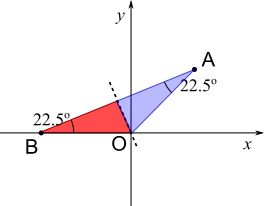
The triangle is isosceles, so the angles at A and B are equal. Since all of the angles add up to $180^\circ$, these angles must add up to $45^\circ$, or must be $22.5^\circ$ each.
Now imagine cutting the triangle in half along the dotted line, and then rotating the blue part, so that the two
Image
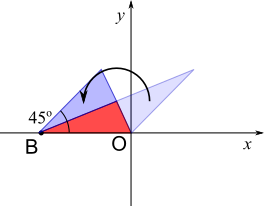
Notice that the triangle is still isosceles, because the image of OA is the side sloping upwards from B.
Image
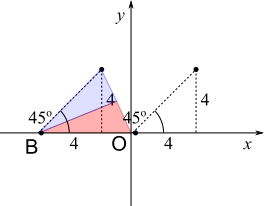
The base of the new triangle is still OB, which is $4\sqrt2$ os $5.657$ units.
So the area of the new triangle is $\frac12\times4\times4\sqrt2=8\sqrt2$ or $\frac12\times4\times5.657=11.31$ square units.
What happens if you apply the formula $\text{Area}=\frac12ab\sin{C}$ to this new triangle? How does this compare to the answer you get if you use the trigonometry method above?
